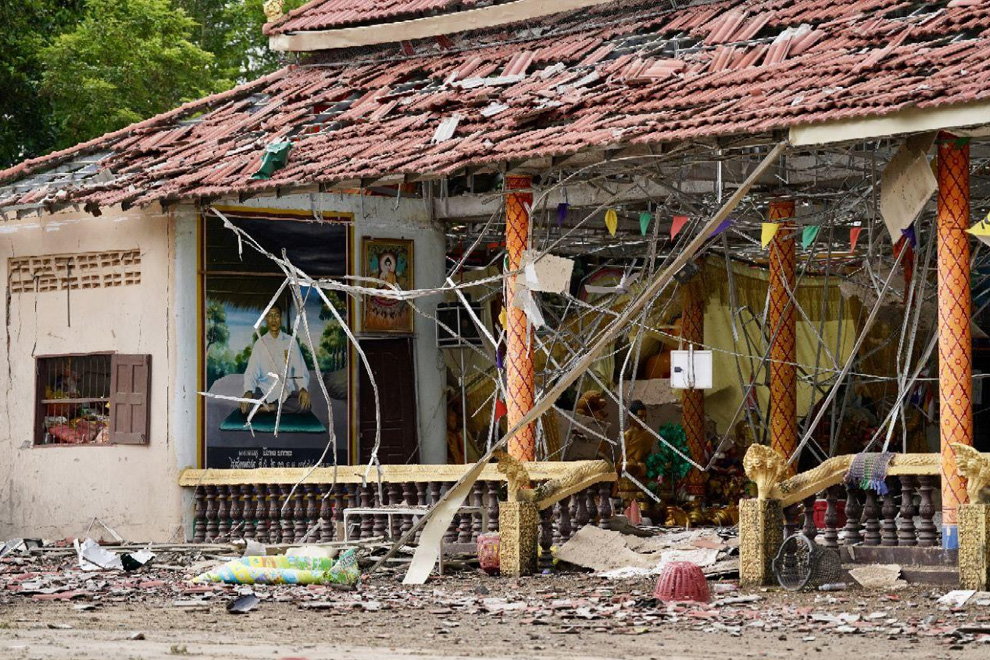 A pagoda in Oddar Meanchey province was extensively damaged, reportedly by an airstrike by a Thai F-16. FN
A pagoda in Oddar Meanchey province was extensively damaged, reportedly by an airstrike by a Thai F-16. FN
In the early months of 2025, a shadow loomed over the Thai-Cambodian border. It was cast by Thailand’s deliberate provocations that have since erupted into a perilous border war, threatening to destabilise Cambodia’s sovereignty, economy and spirit.
From February’s diplomatic affronts to the present’s thunderous F-16 fighter jets and intimidating naval assaults, Thailand has orchestrated a campaign of escalating aggression, leveraging its military might and geopolitical clout to provoke a conflict designed to weaken its smaller and weaker neighbour.
This is not a tale of mutual misunderstanding but rather a calculated strategy to assert dominance. Cambodia’s vulnerabilities are exploited while the intentions are disguised as claims of self-defence. As of 2.26pm on Saturday, July 26, Thailand’s actions — rooted in a pattern of diplomatic intimidation, military mobilisation and outright warfare — reveal a chilling intent to push Cambodia to the brink.
The spark was struck on February 13, when Thai soldiers barred Cambodian civilians from singing their national anthem at the disputed Ta Mone Thom Temple, a sacred site claimed by both nations. This was far more than a minor border dispute; it was a forceful demonstration of Thai authority that disregarded Cambodia’s historical claims upheld by the 1962 International Court of Justice (ICJ) decision in favour of Preah Vihear.
Four days later, on February 17, Thailand’s Ministry of Defence escalated the affront with a scathing letter, accusing Cambodia of “inappropriate behaviour” and labelling the peaceful civilian visit a violation of territorial agreements. This diplomatic salvo was designed to paint Cambodia as the aggressor, thereby establishing a contentious narrative that would justify Thailand’s next steps. By framing a cultural act as a territorial incursion, Thailand sowed the seeds of conflict, exploiting nationalist fervour to prepare its public for escalation.
By early May 2025, Thailand’s intentions became clearer as the Thai 2nd Army Region mobilised tanks and artillery along the border, declaring “full combat readiness” in response to alleged Cambodian incursions.
With a military force of 361,000 personnel, 400 tanks, and F-16 and modern Gripen jets dwarfing Cambodia’s 124,300 troops and limited firepower, this deployment was less a defensive posture than a menacing display of force. The rhetoric of an impending Cambodian “invasion” was absurd, given Cambodia’s military constraints, yet it served to intimidate and provoke. On May 28, 2025, Thailand’s aggression turned deadly when its forces attacked a Cambodian trench in Preah Vihear province, killing a soldier “still in his shorts” during an early morning patrol.
The soldier’s unprepared state, as reported by Cambodia’s Ministry of National Defence, depicts a surprise assault on a routine position, undermining Thailand’s claim that Cambodian fire provoked the clash. This unprovoked killing marked a turning point, plunging bilateral relations to their lowest in a decade and revealing Thailand’s deliberate scheme to use lethal force to assert dominance.
June 2025 brought further escalation as Thailand tightened its grip on the border. On June 7, the Thai defence ministry, backed by the National Security Council, delegated full authority to regional commanders, reinforcing troop presence and imposing stricter border controls. This act, particularly in Trat province, foreshadowed the coastal assaults to come, granting field commanders the power to escalate without diplomatic oversight.
Later that month, on June 26, the Thai Navy claimed to have shot down four “Cambodian” drones over Chanthaburi, a provocative accusation lacking evidence and designed to justify naval mobilization. By framing Cambodia as a surveillance threat, Thailand laid the groundwork for expanding the conflict to coastal fronts, exploiting its naval superiority of 70,000 personnel against Cambodia’s meagre 2,800.
The crisis further intensified on July 23, when a landmine injured a Thai soldier near the border. This prompted Thailand to take the undiplomatic step of recalling its ambassador from Phnom Penh and expelling Cambodia’s envoy, accusing Cambodia of planting mines without proof. This marked the second landmine injury within a week, following an earlier incident in which a Thai soldier lost his leg after a similar unauthorised incursion into Cambodian territory. These were acts that contravene the terms established in the 2000 MoU.
This diplomatic rupture, rejecting Cambodia’s calls for bilateral talks, set the stage for violence. On July 24, Thailand unleashed a full-scale assault near Ta Mone Thom Temple, deploying six F-16 jets to strike Cambodian positions (including schools and a pagoda) in Oddar Meanchey and Preah Vihear; actions Cambodia condemned as “unprovoked, premeditated and deliberate.” Thailand’s simultaneous closure of all land borders and evacuation of 40,000 civilians framed Cambodia as a dangerous aggressor, justifying further military action. By July 25, clashes spread to 12 border locations, with Cambodia alleging Thai use of cluster munitions; a charge Thailand denies but echoes 2011 accusations, targeting civilian areas, including a school in Oddar Meanchey.
Thailand’s rejection of ASEAN mediation, retracting support for chair Anwar Ibrahim’s ceasefire proposal on July 24, exposed their intent to control the conflict’s terms, avoiding international scrutiny that could favour Cambodia’s ICJ-backed claims. The declaration of martial law in Trat and Chanthaburi on July 25 signalled a new phase of aggression, preparing for coastal operations. This culminated on July 26, with the Thai Navy’s “Operation Trat Pikhart Pairee 1”, a naval assault of artillery fire striking Thmor Da and Veal Veng in Pursat and Koh Kong provinces at 5.02am, opening new fronts near Koh Kong. These actions in areas not subjecting to territorial dispute, leveraging Thailand’s naval dominance, aimed to overwhelm Cambodia’s defences, threatening its coastal and inland stability.
The establishment’s narrative, portraying the conflict as mutual provocation, obscures Thailand’s preconceived strategy. Thailand’s claims of Cambodian drones, rockets and landmines lack independent verification, while Cambodia’s smaller military and reliance on international legal mechanisms like the UNSC and ICJ suggest defensive responses to Thai aggression. Thailand’s superior resources, including a $7.3 billion defence budget, advanced weaponry and strong alliances with the United States, allow it to escalate conflicts with impunity. In contrast, Cambodia’s limited capabilities severely restrict its ability to respond.
Thailand’s provocations are not random but a deliberate march to war, intentionally designed to weaken Cambodia. By contesting disputed territories, Thailand undermines Cambodia’s sovereignty. By targeting border regions like Pursat, Koh Kong and Banteay Meanchey, it disrupts Cambodia’s trade and tourism-based economy, displacing more than 37,000 residents and damaging infrastructure. By rejecting ASEAN and UNSC mediation, Thailand isolates Cambodia diplomatically, forcing negotiations on Thai terms. The killing of a Cambodian soldier on May 28, followed by airstrikes and preparation for naval assaults, reflects an ill intent to provoke a conflict Cambodia cannot sustain, risking military defeat, economic collapse and regional marginalisation.
To the nations of the world, ASEAN, the UNSC members and major powers, we implore you to scrutinise this timeline and discern the truth: Thailand stands as the provocateur, bent on destabilising Cambodia through relentless aggression. Cambodia, scarred by the Indochina War, civil wars and genocide, has endured enough suffering, too often watched by a world that owed it protection. Today, we plead for action: to pressure Thailand to submit to the ICJ for a permanent resolution, forging a border of peace and cooperation that uplifts millions across both nations. A just demarcation, rooted in international law, promises sustainable stability for the region, sparing Cambodia unnecessary suffering and violence. The world must not stand idly by again; this is the decisive moment to repay Cambodia’s resilience with solidarity, ensuring a future of harmony over the ashes of past wars.
Long Sovitou is a researcher at the Center for Southeast Asian Studies at the Institute for International Studies and Public Policy (IISPC). Neak Chandarith is an associate professor at the IISPC. The views and opinions expressed are their own.


